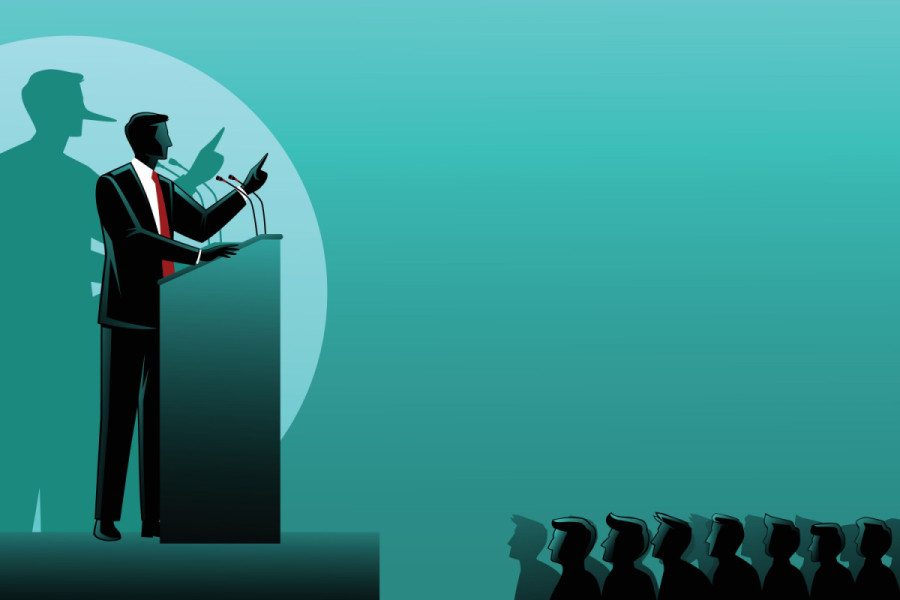Columns
A eulogy to unfact
During election campaigns, when truth is reduced to pithy slogans, facts are far from simple errors of details.
Dharma Adhikari
Om Vitatha Namah! Salutations to the auspicious one! Thus is Sanskrit hymn consecrated to the demigod of untruth, mentioned in Vastu Shastra. Auspiciousness and falsehood find an odd consonance here.
In another salutation, in Brahma Purana, Daksha, also known as one of the Prajapatis, the lords of creatures, eulogises Shiva, invoking his one thousand and eight names, epitomising often contradictory attributes.
In his prayer, described as “the most excellent among all hymns” and which has the potency to liberate the reciter “from all sins,” Daskha cries out: “Obeisance to Tathya [truth]. Obeisance to Vitatha [untruth].”
Dakshya must have been suggesting the non-duality of experience, at the abstract level, in which whatever that is not truth, requires a humble recognition for what it is (or not), to tell apart the whole truth.
In everyday life, there are grey areas between truth and falsehood. Reporters and fact-checkers may try to “get it right” or debunk claims when they can, objectively. They may be able, occasionally, to spot verifiable errors of grammar or details such as typos, spellings, names, and numbers.
During election campaigns, when truth is reduced to pithy slogans, facts are far from simple errors of details. No side appeared eager to accept falsehood on its part, let alone pay obeisance to them. We hear strident narratives of honesty and public service. And narratives, rooted in relatable characters, anecdotes, rhetoric, story plots and emotional appeals, do have the shrewd capacity to render falsehood true or probable, or to at least muddle public judgement. Our worldly Prajapatis often achieve this effect by hammering lies into a semblance of truth.
Overarching electoral claims were at the mercy of the voters’ partisan judgement and ever more less at the evidence or journalistic truth-telling: Gathabandan for safeguarding the constitution. UML for stability. The wave of independents to sweep away the old guard. This election is unlike others.
The fact these claims have been made is the only objective fact here. The rest are assertions, impossible to conclusively falsify.
The toxicity of the perennial, self-loathing national lore, mixed with facts, half-truths, and claims, permeates our psyche. And election season re-enacts another episodic burst of the lore’s magma reservoir: Sati-cursed. Ever-bickering parties. Unfulfilled promises. Citizens shortchanged. Prostration before foreign lords. Another Sikkim in the waiting. All because of corrupt netas. Etcetera.
Quite a contrast to the equally persisting historical narratives on Nepalis as distinguished by honesty, mutual tolerance, courage, independence, and resilience.
Some of the despairing claims were beyond the capacity of deadline journalists or fact-checkers. How do you fact-check ingrained cultural-historical rhetoric that may be doing far more damage to the integrity of public communication than do journalistic typos, misspellings, or anonymous sourcing? Such claims require the rigour of in-depth reporting and the scrutiny by independent think tanks and scholars, and far too little is happening in this area.
Seemingly agreeable claims can be fraught with flaws: The country would sink if leader X is elected… Our rapacious leaders compete to validate the worst in us... These may be mostly partly true to not true at all, objectively speaking, and yet the speaker must have been truly speaking his mind out.
Fact vs “in fact”
In our highly mediatised world where speed and emotionalism impede accuracy, facts are time and resource intensive. The illusion of facts may help to make for the lack of facts. Linguistic devices serve the purpose: in fact, indeed, certainly, of course, without a doubt... Appeal to the crowd: everyone is saying it, people believe it, the word in the streets is that...
Appeal to media: it has been reported, it is already out in the media...Candidates, their intermediaries or opponents cite the media to validate their claims even as they bemoan their declining trust in the media. Appeal to self: As I have said it many times before; I have evidence to that effect, but I don’t want to go into that now.
Hard news, with heavy reliance on attributions, may look authoritative, but facts come without much context. How something is conveyed is indicative of the nature of facts, for instance, using or not using anonymous sources, designations, background information, or multimedia elements on online platforms.
Lack of context, in the form of missing event dates and location names, is evident in many social media posts and, to a lesser extent, on online news sites.
Another pretence of facts tends to show off expert stats, as was the case recently when the Home Minister, citing “an undisclosed study”, pushed (dis)information about his party’s lead in the polls. Some outlets fell for it. Factification, even by unrepresentative surveys and polls data, or random vox pops is a popular technique to delude the audience. Some candidates or supporters tell you they are 200 percent confident about their win.
There is also the fact of emotional resonance, for producers as well as users. They select, present or use information that reaffirms their emotions or biases. This was partly evident in reports of misrepresentations and smear campaigns against certain candidates by some online outlets. Social media instantly validates users’ own emotions. So much so, that digital amnesia may lead them to believe anything they liked elsewhere online, came from their own favourite channel.
Search is by loyalties, either one of the many fossilised Pajapatis now decidedly on the left or the resurging ones on the right, or the aspiring inbetweeners of the independent types. Unlike in news where sources and a neutered voice dominate the copy, characters and drama unfold on social media channels with quirky commentators. How they say it is the truth, not necessarily what.
The fact of eloquence has been reduced online to endless bluster, more vitriol than empathy, more heat than light and the ability of influencers or pranksters to improvise, edit, or distort. It seems eloquence is about weaponising shots or clips against your opponents. The fakes are real and engaging. The algorithm delivers to you more of the impersonators of KP Oli and SB Deuba.
Finally, there is also the fact of format and news routines, a subject of persisting misunderstanding between journalists or producers and users. Readers tend to expect background or explanation in a breaking story; unaware that a follow-up may already be underway. They have to be told that news does include different perspectives or quotes for balance while op-eds can be argumentative and subjective. A journalist was criticised by a reader for a sensational headline in his story, which he did not write, but he had a hard time explaining that reporters write stories, not headlines!
Journalists, producers and editors have to be told that they have to educate the public on the facts of their inner workings, so that they earn discerning and more appreciative audiences.
Recognise unfacts to better appreciate facts. This was my way of making an offering of words for the ritual warding off of Vitatha.




 6.59°C Kathmandu
6.59°C Kathmandu















